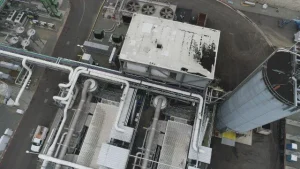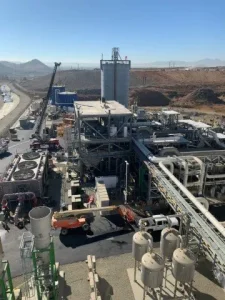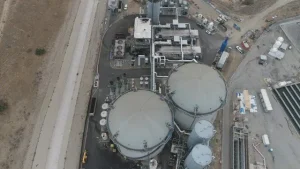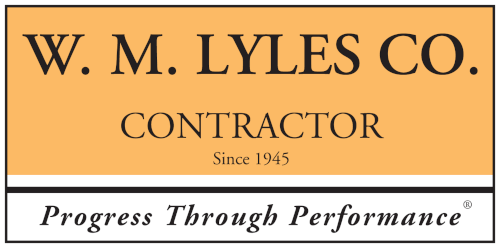Challenge
Renewable natural gas (RNG) is a clean fuel that can be used to heat homes and businesses, for cooking, and to fuel trucks and buses. Today organic waste from farms, landfills, and wastewater treatment plants accounts for about 80% of methane emissions in California. To combat that issue, California lawmakers passed Senate Bill 1383 requiring organic waste collection and recycling services to divert 75% of the state’s organic waste from landfills by 2025, with provisions for energy delivery to customers as part of the state’s plan to reduce greenhouse gas emissions.
Approach
W. M. Lyles Co. (Lyles) teamed with Anaergia, a global leader in both the agricultural and the waste sectors to deliver this one-of-a-kind, progressive design-build project. The Anaergia-Rialto Bioenergy Facility (RBF) addresses two pressing waste management issues in Southern California: food waste diversion from landfills and biosolids management.
The RBF is designed to convert 700 tons per day of food waste and 300 tons per day of biosolids into renewable natural gas, renewable electricity, and Class A organic fertilizer, making it the largest project of its kind in the United States. The design includes a receiving and pre-processing area in which both wet fraction (food waste) and biosolids cake (dewatered sludge) are received and stored separately inside two storage silos. The cake from the cake silo is fed directly to the dryer, while the wet fraction is sent through a series of cyclones (dynamic and hydro) to remove any remaining inorganics before being sent to anaerobic digesters. The wet fraction is biologically broken down within the digesters and methane (biogas) is released. The digestate is sent to a centrifuge to be dewatered and the centrate is treated at the new wastewater treatment plant (WWTP) that includes a membrane bioreactor (MBR). The biogas generated is then converted to an RNG through a series of gas conditioning and upgrading process equipment. The biogas supports two forms of renewable energy on this project. A portion of the biogas is designed to operate combined heat and power (CHP) engines that can generate up to 4.6 MW of electricity. This electricity can be stored and used to operate critical loads within the facility during power outages or the electricity can be sold to Southern California Edison; the remaining biogas is collected, upgraded, and pressurized to be sold and injected into the SoCal Gas pipeline as RNG. The biosolids are sent to the dryer and the dried product will then undergo pyrolysis to generate biochar that can be sold as fertilizer.
A 2-megawatt-hour (MWh) battery bank with a 400-kilowatt (kW) inverter and a microgrid controller has been employed to optimize the bioenergy potential and involves controlling the export to the electrical grid, load shedding, islanding, and startup and assisting in deciding critical functions for given time of day or market condition.
The RBF project is an important step toward ensuring residents have access to affordable and reliable energy, all while achieving California’s clean energy goals. This RNG project is utilizing existing waste to deliver clean fuel for trucks and reducing air pollution along freeways, while providing jobs and revenue sources for the county’s residents.
Results
This facility is the largest generator of RNG in California, and the first of several facilities Anaergia is constructing and developing across California to service the landfill diversion and RNG procurement needs of municipalities under Senate Bill 1383.
Using Anaergia’s advanced anaerobic digestion technology and proprietary systems, the facility will produce up to 985,000 MMBTU/year of RNG each year using up to 300,000 tons of waste diverted from local landfills. Creating this carbon-negative fuel from waste will reduce landfilling and decrease greenhouse gas emissions by up to 220,000 metric tons per year—an amount equal to removing 47,500 passenger cars from the road.
“Anaergia contracted W.M. Lyles Co. to do the design-build of our Rialto Bioenergy Facility, the largest landfill-diverted organic waste anaerobic digestion facility in North America. Lyles offered the unique ability to provide design and value-engineering ideas during the project development phase, as well as work on a progressive design-build project, where full designs are being created while work proceeds. Lyles was great to work with when design changes needed to be made, always remaining flexible and responsive. They also were able to add staff or perform work on a flexible schedule to help us keep the project moving. Finally, their quality of work is second-to-none and it shows in the finished project.”
– Yaniv Scherson, Anaergia Chief Operating Officer




